



LEARN MORE AND DOWNLOAD YOUR FREE BOZEMAN TRAVEL GUIDE!








LEARN MORE AND DOWNLOAD YOUR FREE BOZEMAN TRAVEL GUIDE!



8EEditor’s Note The lesson of powerful rivers
9EInbox & Ear to the Ground Letters, opinions, poetry, and industry news
10ERoad Trips Five National Parks that are road trip worthy


12EPacific Crest Trail A journey through the North State
16EIndigenous Watercraft Rekindling the Native coastal culture
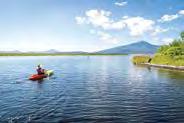
20EHow To Catch Wind Tips for setting sail
22EFreediving Exploring the depths of human endurance on one breath
24EWhitewater The big runoff has raft guides on their toes
26EDownieville Classic This legendary MTB event celebrates 25 years


32EEarn Your Beer Volunteering and Gravity Heights
12
33EEvents Calendar Upcoming races and events
38EGear We Love Goodies for your active lifestyle
THIS ISSUE IS MADE POSSIBLE BY: A Single Track Mind, Adventure Van Expo, Bear Valley Adventure Company, Bike Monkey, Bishop Visitor Center, CAL FIRE, Death Ride, Discover Klamath, Eastside Sports, Four Wheel Campers, Kayak Connection, Kula Cloth, Leki, Nakoma, O'Neill Yacht Charters, OARS, OATBRAN, Pacific Edge Climbing Gym, PedalPalooza, Petzl, Rab, Race the Rails, Recover, RecPak, Ride the Rim, Santa Cruz Mountains Challenge, SCP Hotels, Strawberry Jam Run, Tahoe Fund, Tahoe Keepers, Tahoe Nalu, Tributary Whitewater Tours, Visit Big Bear, Visit Bozeman, Yuma Arizona
2023, #129 ON THE COVER: Rafters drop through Lower Ruck-a-Chucky Falls on the Middle Fork of the American River. The Class IV commercial stretch is one of the most popular rafting trips in California and features the famous Tunnel Chute rapid. Photo Credit: Dylan Silver/OARS .








PUBLISHING + EDITORIAL
PUBLISHER
Cathy Claesson cathy@adventuresportsjournal.com

EDITOR-IN-CHIEF
Matt Niswonger matt@adventuresportsjournal.com
EDITOR
Michele Lamelin & Krista Houghton
COPY EDITOR
Jennifer Stein
CONTRIBUTING PHOTOGRAPHERS
Matt Johanson, Ken Etzl, John Dayberry, Tim Davis/Patagonia, Native Like Water, Michael Timm, Scott Racette/SV Azimuth, Marissa Neely, Kenna Shine/SV Sitka, Tributary Whitewater Tours, Dylan Silver/ OARS

COVER DESIGN
Lauren Worth
EVENTS MARKETING & DISTRIBUTION
Krista Houghton krista@adventuresportsjournal.com
Lee Houghton lee@adventuresportsjournal.com



ADVERTISING
ACCOUNT EXECUTIVE
Cathy Claesson I 831.234.0351 cathy@adventuresportsjournal.com

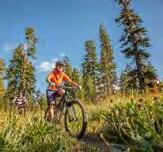


DESTINATION MARKETING MANAGER


Pamela Coffey I 619.887.9937 pamela@adventuresportsjournal.com


LAND ACKNOWLEDGEMENT
Our office resides in Aulinta (‘place of the Red Abalone’) in the larger region called Popeloutchom (‘paradise’) by the Amah Mutsun Tribe.

ADVENTURE SPORTS JOURNAL PO BOX 35, Santa Cruz, CA 95063 Phone 831.457.9453 staff@adventuresportsjournal.com
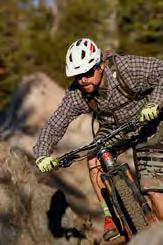

Opinions expressed are those of the authors and not necessarily those of Adventure Sports Journal or our advertisers. We usually agree with our articles, but sometimes we don’t. We welcome all contributions.
All content © Adventure Sports Journal 2023. No part of this publication may be reproduced without permission of the editors.
How is water a part of your adventure planning this summer?
This summer I’m going to explore some class C canyons in Switzerland — swift running water will pose an objective hazard. Grateful for competent friends who can help me not drown. Aaah, the things we do for fun.

On the Pacific Crest Trail, hikers consider water in every decision. Thankfully, the big winter has made it more plentiful than usual.
Living on the Truckee River in Verdi, Nevada and having a neighbor who’s an avid whitewater rafter, I’ve been fortunate enough to experience some of the highest river flows in years these past few weeks.
Water is almost always part of any adventure I plan. Our wet winter has made things so much easier!

My husband and I have made our lives revolve around water! Living on a sailboat means we get to live intimately with the sea, and even when we aren’t on our boat we find ourselves seeking out lakes, rivers and ponds to get our fix.

I’m planning to take some people to Kernville for rafting. Being in the ocean throughout the summer — body surfing, snorkeling, kayaking — will be my water adventures for the next few months.
Warmer water is just around the corner and I’m looking forward to late night sunsets at Cardiff Reef and logging days at San Onofre with friends. Summer is truly a magical time in the Pacific Ocean.
This summer I’d like to do some river rafting with family and friends. There is nothing quite like the feeling of accomplishment after surviving some intimidating rapids in a beautiful river setting.

For most of my life, I’ve been scared of whitewater. I’m humbled to admit that until recently I was terrified of strong river currents. In my youth I spent many days paddling canoes as a summer camp counselor on the Russian River in Sonoma County, but in terms of actual whitewater experience we never went beyond short sections of Class II riffles. So my boating skill level in powerful rivers was non-existent.
Feeling ready to increase my whitewater skills, about 15 years ago I went to the American River near Placerville to face my fears. The plan was to throw myself into the deep end both literally and figuratively.
The Gorge on the South Fork of the American River is one of the most famous commercially guided Class III whitewater runs in the country, and I rented an inflatable kayak to experience this famous whitewater first-hand. With names like Satan’s Cesspool, Deadman’s Drop and Hospital Bar, the rapids in the Gorge are serious whitewater, although considered quite pedestrian by kayaking and rafting experts.
As we made our way to the first rapid in the Gorge, my adrenaline spiked. I was having trouble with my inflatable kayak because it was actually designed for two people and I couldn’t steer very well. Too late, I was beginning to realize that navigating whitewater was all about picking a line in the river and paddling like hell to keep that line. Without a passenger to anchor the front end of my two-person kayak, I was all over the place.
Fully committed now, I went backwards through Satan’s Cesspool. Feeling completely out of my league, I was utterly terrified. The roar of the whitewater was deafening as I locked eyes with some concerned people on the shore. Was it that obvious I didn’t know what I was doing? Somehow managing to stay in my boat through a few more rapids, I finally reached Hospital Bar, and that’s when my luck ran out. My kayak flipped and suddenly I felt like I was drowning. Everything went dark as I struggled to put my head above water. All I can say is thank God for my PFD or I would have certainly died. Holding my paddle with a white knuckle death grip, I floated feetfirst down the remainder of Hospital Bar. At some point a sharp boulder slammed into my tailbone. Recovering my boat in a downstream eddy, I eventually limped back to Santa Cruz, feeling defeated and discouraged.
Over time I realized my mindset was all wrong for whitewater. Instead of being humble and taking a river safety course with experts, I treated the river like a personal adversary to be overcome. As
usual, nature was teaching me something. Whitewater is not an adversary to be defeated, it’s a dance partner to be understood and respected.
Years later I floated the same section of the American River with my family on a raft with professional guides. The contrast couldn’t have been more stark. This time I wasn’t terrified, I was thrilled. In our group of a dozen or so, we had two guides per boat. I began to see how the guides worked with the river instead of against it. Because I was able to let go of my egocentric need to prove myself, Satan’s Cesspool felt more like heaven’s gate than the entrance to hell.
Welcome to issue # 129. It’s the best year in decades for whitewater but we humbly ask that you do not repeat my mistake. Being cocky and callous on the river will lead to terrifying misadventures or worse. With record snowmelt California’s rivers are flowing with the raging power of Mother Nature herself, so please know your limits and act accordingly. Hire a professional guide service with a strong record of expertise on the rivers you want to explore. From the Rogue to the
Klamath, to the Yuba, to the American, to the San Joaquin, to the Kern, to the Santa Ana and every river in between, the thrilling possibilities are endless right now.
In Zen Buddhism, students are urged not to talk about Nirvana. The idea cheapens with every attempt to describe it. In his book Living Buddha, Living Christ, Thich Nhat Hanh tells the story of the old Zen master who tells his students to wash their mouths out with soap every time they say the word, “Nirvana.” The lesson was not to cheapen the goal of Buddhism by reducing Nirvana to a concept. By accepting the inherently contradictory nature of Nirvana we stand a better chance of achieving it. That’s why traditional Zen teachers were so fond of koans, contradictory phrases like “the sound of one hand clapping.” By forcing our brains to consider a realm outside of over-simplified concepts, koans trick us into a state of beginner’s mind, a place where reality is experienced for the very first time.
A good day on the river is like that. Like a Zen koan, whitewater boating can trick us into a state of beginner’s mind. Forced into a contradictory balance between terror and bliss, hot and cold, power and grace, we break free from cynical concepts and experience the eternity of the moment for the very first time. That’s why many seasoned river guides will tell you they love running whitewater with beginners—it reminds them why they fell in love with river boating in the first place.
— Matt Niswonger matt@adventuresportsjournal.comAdventure Sports Journal depends on the support of our advertisers and people like you.

With your support we can continue to inspire adventure, event participation, exploration and environmental stewardship.

ASJ is an important voice for the outdoor community in California, and we are in direct competition with corporate media and online platforms.
Please consider helping us continue our work by becoming a member today.
— Matt Niswonger & Cathy Claesson
Question: Should California residents be given priority for reservations within California State and National Parks?
Results: 75% said YES & 25% said NO
NEXT Question of the issue: What’s more intimidating: kayaking down Class V rivers or big wave surfing in the ocean?
Tell us what you think at river-ocean. adventuresportsjournal.com. The results and comments will be shared in the next print edition.
A Fine Discovery
Morning light sweeps over the horizon full of adventure, we breathe in fresh air, lungs sigh with pleasure.
Slipping arms through straps his life passion my curiosity rose at fifty-six one boot in front of the other fir and pine trees proudly flank the trail butterflies the color of snow, so pure, elegantly float from bloom to bloom the golden sun follows, our thirst sated from water bottles a slight breeze promises relief like an invigorating dip in fresh water.
Resting on the shore, legs stretched, ankles crossed, feeling inconsequential in its vast presence, the surface shines like an exceptional jewel unearthed.
Relatives by nature, dragonflies, like miniature jets, and damselflies with their blue, iridescent wings, gracefully flit about. Surely, they are aware of our captivation.
Tiny threads of peace weave into the marrow of our souls mending any fretting that stirred relentlessly.
A great fortune to play a part with nature in this magical moment of existence, to discover such a gem, just the two of us relishing our sixth decade, just the two of us with our trusty, blue backpacks.
— Lauren Scott, Bay Area
Larren Scott has won $50 and a gift certificate for a bottle of wine from mantrawines.com
ASJ poets, submit your poetry for a chance to get published and win money and wine.
Email poems@ adventuresportsjournal.com
We misspelled our last poetry winner, Talley Kayser’s last name. We regret the error.
My nephew recently surprised me with an Adventure Sports Journal membership as an exchange for a Sierra Club membership I had gotten for him several years back. I hadn’t seen a copy in over seven years. Your team not only sent me the recent issue, but also a back issue via 2-day priority mail. You must have known I needed my ASJ “fix” and what a “fix “ I got! When the copies of ASJ arrived in my mail I devoured both issues immediately. The articles (and especially the heartfelt Editor’s Note) inspire me. I try to live my life so I have no regrets but I have to admit I regret not getting a membership years ago. Your publication touches an emotional chord like no other publication. It is satisfying on so many levels. If there is anything I can do to get ASJ into the hands of those in my area (Lake Tahoe/Carson Valley) please let me know. Your publication needs to stay in circulation, so it can reach and touch more lives. Thanks, from the bottom of my heart, for all you do to keep ASJ alive. I am aware of all the sacrifices you must take to make it happen.
— Michael Caughlan, GardnervilleFolks from Nevada and California gathered together in Minden Park, NV over Memorial Day weekend for the Siren Run to show unity and continued spirit to silence one of the last sundown sirens in the US. A sundown siren was used in communities across the US to give people of color (primarily African Americans) an evening warning to get out of the town limits before sunset or face repercussions like arrest, verbal abuse, possible physical assaults and other extreme measures. The Minden siren was used to get the Washoe Indians, the original inhabitants of the Carson Valley, out of town. The Washoe would become refugees in their own homeland!
The 2023 SIren Run was the third annual event to bring awareness of the original intent of the siren. The event also consisted of a run from Genoa to the upslopes of the Sierra Nevada. As of press time NV Senate Bill 391 is sitting on the governor’s desk for his signature. If he signs it, a loophole in the 2021 legislation that was meant to silence the siren will be closed and the Town of Minden (Douglas County) will face a $40,000 fine for each infraction.
Despite serious environmental concerns and the availability of more sustainable alternatives, the proposed Thacker Pass open pit lithium mine in northern Nevada continues to progress despite better alternatives for lithium extraction elsewhere. The project faces opposition from environmentalists and local communities due to potential harm to delicate ecosystems and water sources. Moreover, the land holds cultural and spiritual significance to Native tribes including the Fort McDermitt Paiute and Shoshone Tribe, and the Duck Valley Shoshone-Paiute Tribe among others who view it as part of their ancestral territory. The mine’s advancement raises concerns about the preservation of Indigenous rights and the need for meaningful consultation.
“There are more important considerations than just money. This proposed mine is just wrong no matter how you look at it,” said Gary Mckinney of the Duck Valley Shoshone-Paiute Tribe during a recent interview with ASJ editor Matt Niswonger.
The Wildlife Conservation Board (WCB) approved approximately $83.15 million in grants to help restore and protect fish and wildlife habitat throughout California and, in some cases, provide new and improved public access, recreational and educational opportunities.
Among the 28 projects approved, the WCB provided a $24 million grant to The Wildlands Conservancy for a cooperative project with the State Coastal Conservancy to acquire approximately 11,691 acres of land in the Carmel Valley in Monterey County for the protection of upland and lowland habitats and the wildlife species they support. The property, which exceeds the total acreage of some state parks, will provide wildlife-oriented education and research along with compatible public and private uses.
The California Fish and Game Commission acted unanimously to enact a full closure of California’s recreational salmon fishing season in the Klamath River Basin and Central Valley rivers. In a separate emergency action, the Commission also voted to close recreational salmon fisheries in the Smith and Eel Rivers, and the summer season in the Klamath and Trinity rivers. Additionally, the Commission voted to allow federally recognized tribes that currently or historically used the river segments affected by the recreational fishing closures, to continue fishing under existing inland sport fishing regulations. The regulations are expected to take effect no later than July 1, 2023.
“This decision, while difficult, is intended to allow salmon to recover in order to provide future fishing opportunities,” said California Department of Fish and Wildlife Director Charlton H. Bonham. “Salmon are an iconic species in California. We treasure them for their intrinsic, cultural, recreational and
commercial values. The state is committed to ensuring long-term survival of our salmon runs and supporting our struggling fishing communities.”
In response to a surge in visitors and growing demand for camping and dayuse facilities, Nevada State Parks is set to launch an online reservation system this fall. The system will enable users to reserve campsites, cabins, group use areas, tours, and special events. It will also provide the convenience of purchasing annual and day-use permits. Additionally, select parks will pilot dayuse reservations to alleviate traffic congestion.
While reservations are not mandatory, they are recommended for those seeking specific dates and locations. Reservations can be made up to 11 months in advance, with modifications allowed up to a month prior to arrival, subject to applicable fees.
California’s Governor Gavin Newsom introduced the California Comeback Plan, which includes a $1 billion investment in conservation, climate, and outdoor recreation. The plan addresses the increased popularity of outdoor activities and aims to enhance access and meet the growing demand. The proposed investment covers deferred maintenance, new urban greenspaces, outdoor equity grants, K-12 outdoor educational programs, and coastal access grants. The plan also includes building new parks and green spaces.
The goal is to conserve 30 percent of California’s land and coastal waters by 2030. These investments promote outdoor recreation access and climate resiliency. California’s investment in outdoor recreation sets an example for other states and emphasizes the need for infrastructure development and staff resources to sustain outdoor spaces.
School’s out and the open road beckons, inviting you to embark on an unforgettable summer adventure. While California boasts remarkable natural wonders, venturing beyond state lines to explore US National Parks unveils a whole new world of breathtaking landscapes. Whether you embark on a solo journey or gather the whole family, a road trip to these out-of-state gems promises an experience you’ll cherish for a lifetime. Although popular during this season, with careful planning and an open mind, discovering the wonders of out-of-state National Parks is a rewarding escapade. Here are five enticing picks to ignite your wanderlust.

Location: Nevada • EST: Oct 27, 1986 • Most known for: Ancient forests and limestone caves • Fun fact: It’s home to the only glacier in Nevada • Average temps: June — Avg High 76 & Avg Low 48 // July — Avg High 86 & Avg Low 57 • Distance and drive time: San Francisco — 520 miles // 9 hours • Los Angeles — 400 miles // 7 hours • Las Vegas — 300 miles // 4.5 hours • Reno — 380 miles // 6 hours *

Location: Oregon • EST: May 22, 1902 • Most known for: Large deep blue lake, which was formed by the collapse of an ancient volcano • Fun fact: It is the deepest lake in America and clearest lake in the world • Average temps: June — Avg High 75 & Avg Low 45 // July — Avg High 80 & Avg Low 53 • Distance and drive time: San Francisco — 400 miles // 6.5 hours • Los Angeles — 800 miles // 12 hours • Las Vegas — 740 miles // 11.5 hours • Reno — 300 miles // 5 hours *
Basin National Park is a refreshing mountain getaway, offering respite from the Nevada desert heat. It is also one of the least visited National Parks in the US. Take a hike to the foot of Wheeler Peak Glacier, the only glacier in Nevada, and marvel at the icy formations. Adventurous families can tackle the challenge of reaching the summit of Wheeler Peak, the second highest peak in Nevada at 13,065 feet. Other scenic trails like the BristleconeGlacier View Trail, showcase ancient bristlecone pine trees and panoramic mountain views. For beautiful alpine lakes, head to Stella Lake and Teresa Lake which are easily accessible via the Alpine Loop/Bristlecone trail. Make sure to explore the Lehman Caves, where guided tours take visitors through stunning limestone formations.
NPS tip: Great Basin National Park is located in extremely remote, eastcentral Nevada, five miles west of the town of Baker. This is a remote area with limited services, little to no cell coverage, no public wifi, and large stretches between gas and grocery services. Plan ahead and pack diligently in case of breakdowns, unexpected snow/dust/lightning storms, and no quick access to many conveniences. nps.gov/grba
PETS: Leave Fido at home. National Parks have strict restrictions on pets. So, though your pets are cherished family members, leaving them at home during national park visits allows you to better immerse yourself in nature and enjoy the experience.
Startenjoying the only National Park in Oregon by embarking on a scenic drive along Rim Drive, where the whole family can marvel at the deep blue waters of Crater Lake and enjoy the various viewpoints along the way, such as Watchman Overlook, Discovery Point, and Cloudcap Overlook. Hiking trails, like the Garfield Peak Trail or Discovery Point Trail, provide opportunities to explore the park’s unique volcanic landscape and encounter diverse flora and fauna. The Cleetwood Cove Trail leads to the lake’s edge, where families can take a refreshing swim or enjoy a boat tour to Wizard Island. Parts of the rim of Crater Lake are steep and can be dangerous, especially for young children, so please make sure to keep an eye on little ones.
NPS tip: May and June are months of transition in the park, as winter slowly gives way to summer. They can also be months of frustration, as lingering snow prevents access to much of the park. The road around Crater Lake and the park’s North Entrance might be closed due to snow. Before you visit, learn about seasonal road closures and check the current conditions to find out which roads are open. nps.gov/crla
CAMPING: If you don’t have a site confirmed, check regularly for cancellations, or try first-come, first-served sites, overflow camping, nearby national forests or private campgrounds. Consider using a thirdparty camping app to find availability. Flexibility and arriving early are key.
* Travel times and distances provided are approximate and can vary depending on road conditions and traffic. Check for road closures and make sure your point of entry to the park is open. Some of these drives are quite desolate, so plan to fill up the tank and have a plan for bathroom emergencies and make sure you have plenty of snacks on hand.

Location: Washington • EST: June 29, 1938 • Most known for:
Incredible natural diversity • Fun fact: The Hoh Rainforest is one of the wettest places in the continental United States • Average temps: June — Avg High 62 & Avg Low 46 // July — Avg High 68 & Avg Low 51 • Distance and drive time: San Francisco — 865 miles // 14 hours • Los Angeles — 1200 miles // 19 hours • Las Vegas — 1200 miles // 19 hours • Reno — 760 miles // 13 hours *

Olympic National Park is very large, offering a diverse array of ecosystems to explore and appreciate. Home to three national wildlife refuges and Olympic Coast National Marine Sanctuary, the Pacific coast’s most popular areas are Kalaloch and Ruby Beach. Four rainforests, including Hoh, one of the finest remaining examples of temperate rainforest in the United States, are popular destinations to experience this grand lush, green environment year-round. Elwha and Sol Duc valleys provide dense, green forests and sparkling rivers. Glacially
Location:
carved Lake Crescent is an alluring attraction for pristine, natural beauty.
NPS tip: Hurricane Ridge is closed indefinitely following the tragic loss of Hurricane Ridge Day Lodge due to fire on May 7. Access to Hurricane Ridge area remains closed beyond Heart of the Hills entrance station. In addition, a portion of North Shore Road (Lake Quinault) is closed due to storm damage. nps.gov/olym
PASS OPTIONS: $35 one week / $70 annual / $80 America the Beautiful provides year-round access to multiple parks. nps.gov/planyourvisit/passes

Location: Montana • EST: May 11, 1910 • Most known for:
Glaciers and diverse wildlife • Fun fact: Home to over 700 lakes! • Average temps: June — Avg High 70 & Avg Low 40 // July — Avg High 75 & Avg Low 45 • Distance and drive time: San Francisco — 1,150 miles // 19 hours • Los Angeles — 1,350 miles // 21 hours • Las Vegas — 1100 miles // 15.5 hours • Reno — 900 miles // 15.5 hours *
Glacier National Park offers stunning mountain scenery, crystal-clear lakes, and plenty of opportunities for hiking and wildlife viewing. The park’s Going-to-the-Sun Road is a must-drive, offering spectacular views of the park’s alpine landscape. Be sure to take the time to hike to some of the park’s most popular attractions, including Hidden Lake, Trail of the Cedars, Grinnell Glacier, and Avalanche Lake. If you’re visiting with kids, consider taking a guided horseback ride or boat tour for a unique perspective on the park. With 700 lakes, there are endless opportunities for
first National Park • Average temps: June — Avg High 70 & Avg

Yellowstone is one of the most popular National Parks in the country and for a good reason. It’s home to a wide variety of wildlife, including bison, elk, and grizzly bears, and features geysers, hot springs, and canyons. The park has an extensive trail system to explore, and you can also book a whitewater rafting trip or enjoy fishing in pristine lakes. Old Faithful, the park’s most famous geyser, erupts every 90 minutes or so and is a must-see for anyone visiting the park. Other popular sights in Yellowstone include the Grand Prismatic Spring, Mammoth Hot Springs, and the Grand Canyon of the Yellowstone.
picnicking, swimming, and kayaking. Wildlife enthusiasts can go on wildlife spotting adventures to catch glimpses of bears, moose, and mountain goats.
NPS tip: In summer 2023, a vehicle reservation is required for four areas of the park: Going-to-the-Sun Road, the North Fork, Two Medicine, and Many Glacier. Each location has unique details and requires a separate reservation. Glacier has become an extremely busy park. Expect crowds on roads, at visitor centers, on popular trails, and on shuttles.
NPS tip: Take the pledge. Tell a friend. Protect the park. The National Park Service works hard to protect Yellowstone and they need your help. The best way to start is by taking the Yellowstone Pledge. It’s a personal promise you make to yourself and the park. It can be taken anywhere: it doesn’t need to be taken out loud or in front of anyone. Tag #YellowstonePledge and encourage others to do the same. “I pledge to protect Yellowstone National Park. I will act responsibly and safely, set a good example for others, and share my love of the park and all the things that make it special.”

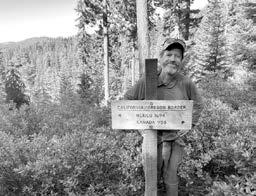
 By Matt Johanson
By Matt Johanson
Foot,
Clean,
You Can Eat … and Matt? Pacific Crest Trail (PCT) hikers rarely use their real names with each other. Early on their way from Mexico to Canada, most adopt a trail name connected to a funny story or their personality. Trail names help build community and give hikers something to talk about when they meet.
Ididn’t have one when I started my “North State” (Northern California) section hike at Lassen Volcanic National Park. Because I began in July, I joined the trail halfway through its 2,650 miles. That should let me reach Canada before snow sets in, and I can detour south for the California desert next spring. So in my first days of hiking, I felt a bit out of place every time I gave my real name to another PCT hiker. No one rushed to suggest a trail name either, as happens often early on the route. How does one choose a new identity? I thought about that for a few hundred miles.
Along the way, a bear who wandered through camp surprised me but did no harm. A skunk alarmed me more but left me no stinkier than before. On the other hand, the quarter-sized blister on my right heel proved a real problem, forcing me to hike in sandals for 50 miles while my wife Karen shipped my running shoes.
I love Lassen Volcanic National Park, where I’ve enjoyed many hikes, climbs, and ski outings. So it hurt to see results of the 2021 Dixie Fire which burned about two-thirds of it. Fire occupies the minds of all PCT hikers, who know a blaze could end the journey at any time.
But I enjoyed detouring to the summit of Fairfield Peak, and then later, to Subway Cave and Burney Falls. Most other hikers stick to the trail and avoid any extra mileage, but I like taking side trips to see more scenery, and the Cascades are mostly new to me.
Hat Creek Resort provided my first bed and shower, which felt great. All the hikers congregate at such havens from trail rigors. The resort’s hosts kindly tolerate the pack of dirty vagabonds drinking beer, stuffing themselves and charging their phones. In such places, hikers also resupply with food and supplies for the next push, either at stores or from boxes they ship themselves.
Summer heat requires an early start, so in Lassen National Forest, I hit the trail by 5am. The trail rewards long hiking days with quicker arrivals at trail towns, which allows lighter pack weight. I planned on hiking 15 miles a day but I’m averaging 20, and plenty of others do more than that.
Though I’ve been backpacking for decades, I find I still have more to learn. For instance, water requires more attention here than other places I’ve hiked. In the North State, the PCT often extends more than a
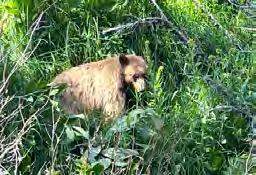

dozen miles between sources. These days, virtually all hikers rely on the FarOut app to locate water sources, campsites and more; no longer is the backcountry a retreat from phones and technology.
I also found new ways to lighten my gear, shipping home unneeded clothes and trading in my sleeping bag and cookware for lighter replacements. That brought my base pack weight (without food or water) to 17 pounds, which isn’t bad, though many travel with even less.
So in my first days of hiking, I felt a bit out of place every time I gave my real name to another PCT hiker. No one rushed to suggest a trail name either, as happens often early on the route. How does one choose a new identity? I thought about that for a few hundred miles.
I’m losing weight, too, and not on purpose. Hiking all day while eating little takes a toll and I lost more than ten pounds in my first weeks. Pack weight or no, I need to eat more on the trail. I was glad to discover Packit Gourmet backpacking fare; meals like Texas State Fair Chili and Pasta Beef Bolognese help to satisfy my considerable appetite.
After the burned trees of Lassen, I was glad to reach the healthier Shasta-Trinity and Klamath National Forests, even though they introduced the challenge







of blowdowns. Hikers must clamber over thousands of fallen trees across the full PCT. Some of these obstacles require hard and dangerous climbing on steep slopes, and a few hikers suffer falls and minor injuries. From now on, I’ll appreciate the efforts of volunteers who toil to saw through logs and clear the trail.
Towns like Burney, Dunsmuir, and Etna gave me a chance to catch up on calories. Ravenously hungry, I stuffed myself in each of them, but still lost more weight. In Seiad Valley, the Seiad Cafe offers a pancake challenge: eat an 8.7 pound plate of giant flapjacks within two hours and get the $16 meal for free. Many hikers attempt it but few succeed. I opted for a large plate of bacon and eggs instead.
Trail angels make hiking not just possible but enjoyable. My new friend Megan kindly drove me from Red Bluff to my trailhead near Lassen. Burney’s

Word of Life Church opens its doors to hikers to shower, eat and even spend a night. I know an old friend in Burney; Sarah and her husband and son graciously took me in. In Callahan, I enjoyed a night at rustic Sugar Creek Ranch, which offers excellent fishing for anglers. In Etna, trail angel Molly drove me to town and even found me a cheap room and bed. Several other friendly drivers picked me up when I hitchhiked. Majestic Mount Shasta reminded me of pleasant climbing memories as I hiked beside it. Some hikers even left the trail to climb it, though I opted instead for new and closer summits, like Buckhorn Mountain, Kings Castle and Eagle Peak in Marble Mountain Wilderness.

I enjoyed meeting other hikers like Arrowhead, Troubadour, Bahama Mama, Turtle, Drama, Shaggy and Robin Hood. But as I neared Oregon, I still had no trail name. Other hikers began to notice my affinity for side trips off the main PCT. That sounded like a fun and fitting concept.



So when I reached the register at the California-Oregon border, I signed my new moniker: Detour.


Matt “Detour” Johanson describes his journey on the 2,650-mile PCT in this series. Next time: Forging through Oregon’s Forever Forests.

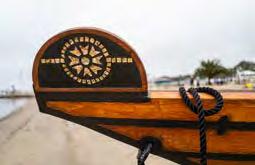
What goes unseen is a culture that’s been dormant for centuries, pushed aside by Spanish missionaries in the 1700s and further buried by westward expansion in the 1800s and 1900s. The original ocean people of California have been suppressed to the point of invisibility, and their influence largely forgotten, but efforts are underway to bring back traditional watercraft through cultural revitalization along the Southern California coast and even in Lake Tahoe.
Chumash Elder Alan Salazar is among those leading the effort of traditional Indigenous canoe revitalization in the Santa Barbara area.

In 2001, Salazar and his community completed the first of 13 crossings to Santa Cruz Island from the mainland in traditional tomol canoes. These traditional canoes were made from redwood trees that drifted down the coast from Northern California. After four years of preparation, paddle training and construction
of the tomol, Salazar and a group of paddlers set out to channel the spirit of their ancestors for the 20mile journey. The paddle marked the first crossing via traditional canoes in more than 150 years.
“We left at 3:45 am and I was in the first crew. To be in that first crew, to paddle out of the Channel Islands Harbor in Oxnard, and get out into open water was something special,” Salazar says. “It was dark and overcast that day. There were no stars and no moon. We had two support boats to lead the way but they were far in the distance. We wanted to experience open-water paddling at night.”
“We called the first crew that leaves at 3:45 am, ‘Dark Water Paddlers,’ and that’s an honor because they’re our most experienced members. They paddle the longest, for at least three hours, so it’s hard physical paddling, but it’s kind of a spiritual rush.”
Since those first crossings, Salazar has been working to connect with tribes and canoe communities throughout the nation, revitalizing canoe culture in a way that transcends tribes. In a recent project with
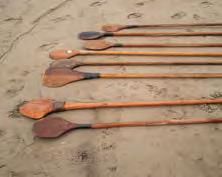
On any given day in Southern California, you can arrive at the beach and see surfers and beachgoers claiming waves and spots in the sand, while weekend warriors try to find parking. This wasn’t always the case.
outdoor brand Patagonia, based in nearby Ventura, Salazar and other Ventura-based tomol builders have set out to build two more tomol canoes, slated for completion this summer.

While the original Chumash used shark fins to sand the tomol canoes, Salazar and his community implement a combination of modern and traditional techniques.
“I’m excited to build these tomols here in Ventura
because the Indigenous community has pretty much been left behind in Ventura,” Salazar says. “So, to end my paddling career, I’m going to help build these two canoes here in Ventura. It will probably be the first time in 180 years since any traditional Chumash canoes have been built in the Ventura area.”
“My attitude, and that of the leaders that I’m working with, is that we want to bring in all people of the ocean. We don’t want just North American tribal people, we want canoe people from all over the world.”
Moving down the coastline into Kumeyaay territory in modern-day San Diego, calmer waters allowed people to travel the coast in tule reed canoes, as opposed to the longer, wooden tomols up north. Tule-style canoes have been used throughout the world by Indigenous cultures. While construction methods vary, all tule canoes were built of reeds and other plant materials.
The San Diego based non-profit Native Like Water works to bring back Native representation in surfing and ocean engagement through their youth programs that include, among other things, the building and paddling of traditional tule canoes.



Native Like Water founder, Marc Chavez, says building traditional watercraft is a way to plant a seed that connects the present to the past — a hands on, practical way to reintroduce Indigenous representation in San Diego’s ocean culture.
“A lot of things have squashed our cultural presences, especially real estate,” he says. “So the revitalization of traditional water craft, is kind of like weeds growing from concrete in the sense that our culture has been so squashed.”
Working with traditional canoes offers those involved an opportunity to engage with social and environmental issues with a new perspective, one that is rooted in a Native viewpoint that strives for harmony with people and the planet.

“So having Indigenous people be a part of the revitalization of nature is important. Leaving the original coastal people out of the story would be like leaving the whale out of the story of the ocean,” Chavez says.
The 20,000-year-old history of coastal land in California has been misrepresented, but the narrative is changing.
John Dayberry is a teacher, skier, surfer, craftsman, and former lift operations manager for Homewood Mountain Resort. Hailing from South Lake Tahoe, Dayberry became fixated on the history and practice of traditional watercraft 15 years ago.
Dayberry sits in his office surrounded by a library of history books. During our interview, he pulls out Tom Blake’s, The Uncommon Journey of a Pioneer Waterman. He cites this text as a key source of inspiration, leading him to understand that contemporary modes of watercraft all stem from Indigenous creation.
His interest in Native watercraft was piqued by a conversation he had with a student in the high school shop class
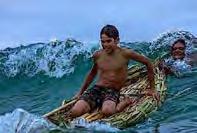
he was teaching. The kid was of the Pomo Tribe, out of Clearlake, CA.
“So, I asked the Pomo student what kind of watercraft his people used, and he said they used tule canoes and they had just built the first one in like a hundred years,” Dayberry says. “So, through that we became interested in the kind of watercraft his tribe was using.”
Then, he realized the Washoe Tribe of Lake Tahoe were most likely using tule reed canoes as well. Dayberry couldn’t find a lot of information about it in the history books, but that didn’t stop him.
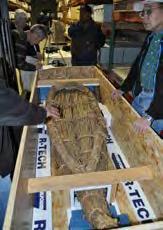

His enthusiasm for paddling and Indigenous watercraft was the inspiration for the Lake Tahoe Paddle Festival, held in 2009. It consisted of a combination of traditional Indigenous watercraft as well as state-
of-the-art canoes, kayaks, and stand-up paddle boards. The festival included a race from South Lake Tahoe to Emerald Bay and back.
“’Ancient art to state of the art’ was the term I used, showcasing traditional watercraft and modern ones,” Dayberry says. “We built a tule reed canoe with some Washoe kids at the event, and that was the first time in maybe 100 or so years that the tribe had built tule canoes.”
Dayberry connects the cultural revitalization of indigenous canoes to environmental sustainability through what is known as Traditional Ecological Knowledge (TEK). Looking at environmental issues like climate change through a lens of TEK helps us combine western scientific perspectives with Indigenous perspectives.

“When you start to go deep into Traditional Ecological Knowledge, it transcends normal science and you start to see relationships that are interconnected, and it’s because you’re looking at it from this transdisciplinary angle,” Dayberry says.
All of this discussion about traditional watercraft begs an important question. What do canoes have to do with saving the planet? “When you bring people back to the consciousness of traditional Indigenous people and how they lived in harmony with their environment, you understand why things are so dysfunctional now. All these catastrophic fires and mega snowstorms are because we’ve shifted everything away from our history and our environment. TEK helps us understand this,” Dayberry says.
“Whether it’s for cultural revitalization or environmental stewardship, looking to the traditional understanding of people and their environment is the way forward,” he adds.
Patagonia has featured Alan Salazar in its new film, Chumash Powered, released April 12, 2023. The film highlights Salazar working alongside his Chumash and Ferdandeño Tataviam communities to pass their knowledge to the next generation of tomol builders and paddlers. It also features a call to action, asking volunteers to aid Salazar and the Tataviam Land Conservancy to help build two tomol canoes in Ventura.
“A lot of things have squashed our cultural presences, especially real estate. So the revitalization is kind of like weeds growing from concrete in the sense that it’s been so squashed.”
— Marc Chavez, Native Like Water founder





 By Marissa Neely
By Marissa Neely
In 2018, my partner Chris and I made the decision to abandon life on land for life afloat, purchasing a 1979 Cheoy Lee 41’ sailboat named Avocet, in Ventura, California. Since then, we have not only redone every inch of our boat to make her more structurally sound and aesthetically pleasing, but have recently cast off the dock lines to go on an indefinite sailing trip that’s referred to as “cruising.”

To the unknowing, it may seem as if we are rich kids living off a trust fund or perhaps early crypto investors that made it big; neither could be further from the truth. In reality, we are minimalists who work hard and choose a humble lifestyle that often gets tied up in an idea of grandeur. This misconception is often what keeps people from dabbling with sailing since the barrier to entry can be intimidating. But here’s the bestkept secret about sailing: you don’t need deep pockets to get started. There are hundreds of ways to learn how to sail on a budget, because the majority of sailors are on a budget. All it takes is a little research, some time, and a lot of persistence. So, here are some ways you can harness the wind even if you aren’t wealthy:
TAKE A LESSON
If you google “sailing schools” you will find a number of courses designed to help you earn the title of “sailor.” The American Sailing Association (ASA) offers a wide variety of hands-on courses for newbies and experienced sailors, teaching everything from the basics of boating to tactical maneuvering. If you sign up for ASA 101, Basic Keelboat Sailing, you will lay the foundation to become a confident small boat skipper. Check with your local yacht club or sailing club to see if any ASA courses (or equivalents) are offered.
Luckily, sailors are social creatures and always looking for an excuse to gather. Therefore, yacht clubs and sailing schools often host open houses where you can get to know the instructors
and the boats, and sometimes even go sailing for free. It’s an easy, low-stakes way to see what sailing is all about and meet some sailors that can help answer your questions and maybe even invite you out for a sail. The more boats you step aboard, the better!
Do you know a friend with a boat? Great! Ask them how they got into sailing or even better, if they would be willing to teach you how to sail. If they are hesitant, ask if they know of anyone that could teach you. This is definitely a bit risky since experience is hit or miss, but it is a more affordable (if not free) option. If you are welcomed aboard, remove your shoes before stepping on and ask what you can bring. If they say nothing you still may want to bring something (snacks, additional clothing, etc). Ask the captain first to make sure there is space — storage comes at a premium aboard some boats and the last thing you want to do is upset the captain!
Although this is a pricier option, it gives you the opportunity to experience the highs of sailing and exploring new places on a boat with a licensed captain. Tell the charter company beforehand you are interested in becoming a sailor, and maybe they will match you with a captain who is willing to share some knowledge. There are charter companies like West Coast Multihulls in California (and Mexico) that offer charters as well as sailing lessons through ASA, so perhaps tune your search for a company that caters to both chartering and teaching for the chance to get the best of both opportunities. Invite your friends or family and make a vacation out of it.
Boat shows are a wonderful way to infiltrate the sailing community and make valuable connections that can help get you on the water. Not only are there brand new boats to drool over there are usually sailing school representatives, local yacht clubs, and charter companies handing out fliers and even boat show discounts. Search online for your nearest boat show and add it to your calendar.
Chris grew up in a sailing family and learned how to trim sails before he could walk, but I didn’t even step aboard a sailboat until I was 14. Chris was the one who taught me aboard his 21’ sailboat, Geronimo, a boat we still sail
today. Since then, I have continued to embrace sailing and became a USCG Licensed captain in 2022. However, despite our combined experience we are still learning new things every day. That’s one of the most exciting parts of sailing, it never gets stale.
Marissa Neely and her husband Chris live aboard their 1979 Cheoy Lee 41’ Avocet. They cast off for cruising in 2022 and are now enjoying the Sea of Cortez, Mexico. You can follow their journey on YouTube (Sailing Avocet) or blog site svavocet.com

Despite our combined experience we are still learning new things every day. That’s one of the most exciting parts of sailing, it never gets stale.



The Bajau, a semi-nomadic people spread throughout Indonesia, Malaysia and the Philippines, grow up underwater – some of them spend 60% of their lives there. BBC footage shows them walking on the sea floor 65 feet below the surface searching for shellfish like they’re roaming the aisles of a grocery store. They’ve evolved larger spleens than neighboring groups, which allows them to dive deeper and hold their breath longer. They are the world’s best freedivers.
Even though humans have been plunging underwater for millennia, modern freediving began in 1949 when an Italian man dove almost 100 feet below the Gulf of Naples on a dare. People immediately wanted to break his record. Fifty years later, there are six officially recognized freediving competitive disciplines. The world record for static breath hold stands at almost 12 minutes, and the deepest anyone has reached under their own power is 413 feet.
But about 90% of freedivers are purely recreational. For about $500 –the cost of a neoprene exposure suit, mask, fins, goggles and a weight belt – anyone can join. The art of exploring the ocean depths on a single lung full of air is the fastest growing water sport in the world. And the waters off the coast of California provide the perfect training ground for developing skills that can be enjoyed all over the world.
“If you train out here in California, with limited visibility, a surf entrance, unpredictable swells and frigid water, it makes you more confident so you can handle environmental variables
anywhere else in the world,” explains San Diego-based instructor Michael Timm, who has been teaching freediving for 14 years. “If you can dive 90 feet in California, you can dive 120 feet anywhere else.“

Training in California doesn’t make a diver invincible, as the surfing community learned in 2001 when Jay Moriarity died freediving solo in the calm warm waters of the Maldives.
“There is no warning for when you get into trouble, so this is a very rule heavy sport,” explains Timm. “If you don’t follow the rules you are going to die.”
The first rule is to dive with a buddy, who will notice signs like a nodding head, tremors, blue lips, dizziness or confusion that can lead to a blackout.
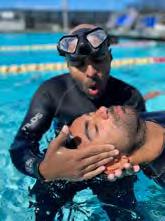
The second rule is to get your weight belt dialed in appropriately. The correct weight makes a diver positively buoyant on the surface after an exhalation. Too much weight means a quick descent, but slows the ascent and will send a diver to their death below the surface if they experience a shallow water blackout. Other rules include not hyperventilating, taking three recovery breaths at the surface,
and not exhaling until you reach the surface, to maintain buoyancy. Like most adventure sports that can kill you, ego and peer pressure are the main causes of freediving casualties. Unlike other adventure sports that can kill you, freediving requires relaxation. Before the peak inhalation that carries them to depth or distance, a diver needs to breathe and relax for a full minute or two. “The final breath should be slow and deliberate. You need to think happy positive thoughts,” explains Timm. “So drop any expectations, forget about time and depth and sink into the feelings, focus on relaxation and equalization.“
Of course, it’s hard to relax when you can’t breathe. The first night of a PADI introductory freediving course takes place in a classroom to learn the theory of why you can hold your breath longer than you thought. It comes down to the delicate balance between CO2 and O2.
“Carbon dioxide is the alarm system in the body, it tells a person when they need to breathe,” explains Timm. “When a person holds their breath, oxygen levels drop slowly, but CO2
levels rise quickly. In effect, the body is giving the alarm too early, telling you to breathe before oxygen runs out.”

It’s also hard to relax when you feel like your skull is a thin-shelled egg being crushed by a giant’s hand, which is what diving at depth feels like. On the second day of an introductory freediving course, students learn to equalize early and often, to bring the pressure inside their ears, mask and sinuses to the same level as the water around them.
While scuba diving, with a constant supply of air, a diver can simply hold their nose, exhale forcefully and pop their ears. But freediving requires a more complex and subtle approach, to conserve energy and preserve relaxation. Trouble equalizing is the major limiting factor in freediving and the reason 20% of participants fail their first course.


After an evening in the classroom, the first full day of a PADI introductory freediving course takes place in a pool, where students can put theory into practice, and push through their fears in a safe controlled environment. They graduate to open ocean diving only after practicing breath hold, and mastering descent, ascent and rescue in a pool.
Breath hold practice is controversial in American pools. “I train military divers, many under the age of 21, who here in the US are allowed to carry and use an MK 15, but not allowed to legally buy a bottle of beer – even these elite soldiers aren’t allowed to practice breath holds on their own time in a pool,” explains Timm, who originally hails from Germany. “In Europe you can lay on the floor of a pool for three
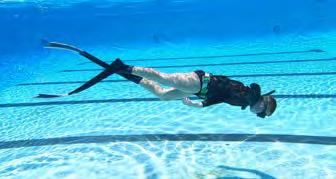
minutes and nobody cares, but in the US if you swim a 25-meter lap while holding your breath, they yell at you and pull you out of the pool. The only reason we can do it at the pool in San Diego is because it’s off hours and there’s no lifeguard on duty.”

Despite growing regulatory hassles and inherent dangers, Timm is committed to training new freedivers, work which takes him from the frigid waters of Alaska to the clear desert lakes of Nevada and the warm oceans of the tropics. “We are teaching people to be safe in this sport,” he says. “Our goal is to prevent people from going out by themselves and drowning. We are educating people to do this safely.” But like all passionate athletes, Timm is ultimately driven by love for the sport. “I feel like I’m meditating when I’m down there. I don’t think about anything, I’m just gliding through the water, everything but the present moment drops away.”
Dive California offers tours and classes and is based in San Diego. If you want to find an outfitter closer to home, make sure they are certified by a recognized agency, such as AIDA, PADI, or SSI.
The
The art of exploring the ocean depths on a single lung full of air is the fastest growing water sport in the world. And the waters off the coast of California provide the perfect training ground for developing skills that can be enjoyed all over the world.
The big runoff has raft guides on their toes
By Anthea RaymondWith 2023’s record snowpack and the “great runoff” in full swing, whitewater paddlers are excited for an extended season. Equally excited are casual participants who want to tap into the fun. This has had outfitters across California busy preparing for a season to remember. With the high-water period lasting late into summer, guides have been going the extra length to make experiencing the magic of big water available to everyone this summer, even first timers.
Typically the high-water season in California ends by mid to late June. This year, we could be seeing high-water through the end of July and maybe even into August, requiring heightened skills, experience, and caution throughout the summer. As Jeremiah Copper of Tributary Whitewater Tours notes, “Going with an outfitter is more important than ever this year.”
Outfitters are prioritizing selecting experienced guides who excel in safety, rescue, river reading, strength, stamina, and leadership and communication skills. How do they find such qualified guides?
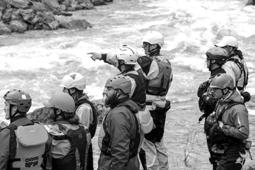

Many guides start by getting their entry-level training through public “guide schools.” These can run for many days and are often where outfitters find new talent, though recommendations and open applications are also a part of the process. For obvious reasons, this year outfitters are relying heavily on experienced guides, especially for their more demanding runs and multi-day trips.
Swiftwater rescue courses, certified by internationally recognized organizations such as Rescue 3 International and Swiftwater Safety Institute, are nearly mandatory credentials. Additionally, wilderness first aid classes are essential for guides to handle health emergencies that may arise, especially on multi-day adventures.
In addition to these standardized courses, outfitters also conduct their own in-house training programs tailored to the skill and experience of their guides. In-house programs are especially important this year after floodwaters reshaped many banks and rapids. The changed dynamics and speed of the water make it more likely rafts may flip and customers will end up in the water. It also means guides can’t necessarily rely on their past knowledge of the river.
So, outfitters have been busy with on-river training sessions, where emergency rescue and recovery drills — such as righting flipped rafts and gathering up swimmers — are practiced. Strong rowing and maneuvering skills are also being drilled. Guides need them to navigate the new routes and to stay
nearer than usual to other rafts — to help out or get help.
Travis Hale of OARS says guides typically make three or four trips with empty boats before taking clients out on an unfamiliar or dramatically changed section of river. Hale, who helps train OARS’ Merced and Stanislaus River guides, also watches how each rower works with other guides. “As much as rafting is an individual sport it is a team sport too.”
Training schedules for most companies this season have been complicated this year too. At some locations, some guides started training as early as March. In other cases, like the Stanislaus and the Tuolumne Rivers, where washed out roads and near
This
A

practices
peak flows made commercial trips difficult in early season, guides will train into June. Finally, companies have also ramped up safety protocols, putting extra safety boaters and emergency protocols in place.
Attention to detail extends beyond the guides themselves. Office staff is carefully trained to coach and relay the proper information to participants before they book their trips. Don’t be surprised to
have someone ask you about your height, weight and physical condition. Screening has become more rigorous, ensuring that clients possess the necessary skills and mindset for the adventure. Minimum age limits have been raised at least through July. You may also be asked to do a “swim test” and show you can climb back into the boat before launching.
Rely on the judgment of the outfitters and be flexible if they recommend an alternative. Outfitters act in the clients’ best interests, but clients need to make good decisions too.
While rafting with reputable outfitters and experienced guides instill confidence, caution is advised when venturing on private trips or with less experienced individuals. Even a professional guide in a casual setting can pose risks.



It is crucial to verify the skills and experience of friends claiming expertise similar to professionals. Moreover, those considering taking friends out should remember that early-season high water is not the ideal time to introduce newcomers to the sport.
There will be great paddling late into fall this year, but it is worth noting that many skilled raft and river guides spend their winter months working as ski instructors and patrollers on ski slopes. With the potential for premium boating post-Halloween, outfitters are already considering staffing strategies. So get it while you can, especially as flows moderate and the weather warms through July and August. Look for that to be the peak period to balance fun and safety, though the fit and adventurous might explore a one-day blast down the full 21 miles of the South Fork of the American River or a high water Merced, Stanislaus, or Kern River trip in June.

How do you summarize the impact the Downieville Classic has had on the sport of mountain biking since its first running in 1995? The hardest part about writing an article celebrating 25 years of the Downieville Classic is figuring out where to begin, as the stories from this legendary mountain bike event tower as high as the Sierra Buttes themselves, and the line between myth and reality as intertwined as gold in quartz.
In the history of mountain biking, no other event has captured the essence of pleasure and pain on two wheels better than the Downieville Classic; it is the granddaddy of all mountain bike events for good reason. As one of the only pointto-point mountain bike races left in existence, the Downieville Classic features a 27-mile crosscountry event starting in Sierra City and finishing in Downieville, opening with a grueling 3,000 vertical foot climb to Packer Saddle before plunging 5,500 vertical feet on trails originally cut during the Gold Rush, laden with every kind of rock imaginable.
But what’s made the Downieville Classic most legendary is the All-Mountain category, combining the cross-country event on Saturday with a 17-mile downhill race on Sunday, starting at 7,000 feet elevation at Packer Saddle and careening 5,000 vertical feet down Butcher Ranch trail to Third and
First Divide trails before finishing in the heart of town. Downieville is the origin of the All-Mountain World Championships, an event testing the true mettle of every participant. To win the All-Mountain requires the ultimate balance of fitness and skill with a little bit of luck peppered in.
For most mortals, finishing the downhill in under an hour is something to be proud of. That’s right, an hour-long descent at full speed. And for good measure, there’s 500 feet of climbing to really burn the memory into the lungs and legs as much as the brain. On the bucket list of mountain bike events, the Downieville Classic ranks at the top, as no other event tests the mental and physical fortitude of its participants more thoroughly. Seven-time winner Mark Weir summed it up in Dirt Magic, a Patagoniafunded documentary about the history of the Downieville Classic.
“If someone underestimates it, they better be really fit, or serves them right,” said Weir. “Freaking hardest race I’ve ever done.”
In addition to pushing the limits of participants, the Classic has also pushed the sport of mountain biking itself. Due to the unique combination of warp speed and abundant rocks, Downieville’s trails have claimed countless broken wheels, frames and handlebars over the years, and shred unworthy tires with delight. The term “Downieville Tough” is a thing, as it’s been the ultimate proving ground for Downieville Classic title sponsor Santa Cruz Bicycles, testing product durability and advancing suspension design since the early 1990s.
The magic carpet-like suspension we enjoy on modern trail bikes can be credited in part to the trails of Downieville, as the riding experience today is worlds different than when the event started in
1995 as the Coyote Classic. Back then, on steel hardtails with

brakes and 80 millimeters of elastomer suspension, racing the Downieville Classic was more about white-knuckle survival and not rattling teeth from your skull than anything else. Today the Classic is more about fun and pushing personal goals instead of pushing the bike to its functional limits.
Beyond the rugged, raw and historic trails, what makes the Downieville Classic so special is the



environment of the Gold Rush-era town, little changed from its founding in the early 1850s. Today, throngs of spectators sit along the North Yuba River watching the Ron’s House of Big Air River Jump contest, just like in the early days of the Gold Rush when throngs of prospectors sat along those same river banks panning for gold.
Today’s population of Downieville is barely 200 year-round residents, when in the 1850s it ranked in the thousands. Considering the Downieville Classic
Support independent media and get a chance to win two tickets for two days at Mammoth Bike Park.



We think ASJ is an important voice for the outdoor community in California. If you agree then consider helping us continue our work by becoming a member and be entered to win two tickets for two days at Mammoth Bike Park. Current members are already entered to win.
Memberships are as low as $5 per month and include a subscription! adventuresportsjournal.com/membership






is the biggest event of the year with thousands of people attending from all over the world, the Classic gives folks a feel of what Downieville must have been like in the early days when gold was abundant and business was booming.


In order to help bolster his fledgling Coyote Adventures guiding company, Greg Williams started the Coyote Classic in 1995. At first, Williams
was met with mixed response from residents, but in Williams’ signature fashion, he didn’t give up, knocked on the door of every resident on Main Street and won them over with his sincerity, receiving their blessing so he could shut down the street for the day to run the event. Williams was also the last person seen in town cleaning up after each year’s event, sweeping trash off Main Street
with a broom; a tradition he has kept alive to this day.
The Downieville Classic is also the only event that ever gave out real gold nuggets, awarding the first man and woman to the top of the cross-country climb with one.

“It’s the only prize I have ever won that has gained value over the years,” said Stosh Bankston, local Nevada City mountain bike legend and Coyote Classic winner.
“If someone underestimates it, they better be really fit, or serves them right. Freaking hardest race I’ve ever done.”
— Mark Weir, MTB legend and eight time winnerThis page, left to right: Flat tires are an inevitability in Downieville, so bring extra tubes and tire plugs (Ken Etzel); Descending Gold Valley OHV Road, aka “Baby Heads” is a wild, fast, rocky and dusty ride (SBTS).
Before 2020, the only year the Classic didn’t run was in 2004, when Williams welcomed his first child into the world. That year, longtime supporter Santa Cruz Bicycles still cut Williams a check for sponsorship of the event, but instead of it going to producing the Downieville Classic, Williams put that money towards funding the creation of the Sierra
Buttes Trail Stewardship, a local non-profit trail building organization celebrating its 20th anniversary in 2023, and the beneficiary of funds raised by the Downieville Classic.


“Without the support of the community and Santa Cruz Bicycles, neither the Downieville Classic nor the Sierra Buttes Trail Stewardship would exist today,” said Williams.
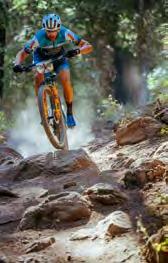

After a three-year hiatus due to COVID and wildfires, the 25th Anniversary of the Downieville Classic returns in grand fashion on July 13-16 after a historic winter dropping record snowpack on the Sierra Nevada. Much like in 2011 when a massive winter forced hundreds of volunteers to shovel out the trail for weeks leading up to the race, only
to watch a last-minute heatwave melt all the snow a few days before the event, the 25th running of the Downieville Classic will also involve snow shoveling to make some of the upper trails passable.
It’s unclear if the cross-country event will use Gold Valley Rim Trail due to snowpack depth, but one thing is for certain: the snow won’t stop the Classic, it will only make the 25th running more legendary, especially the river jump thanks to runoff keeping the river running high all summer long.
For most mortals, finishing the downhill in under an hour is something to be proud of. That’s right, an hourlong descent at full speed. And for good measure, there’s 500 feet of climbing to really burn the memory into the lungs and legs as much as the brain.
Today’s population of Downieville is barely 200 year-round residents, when in the 1850s it ranked in the thousands. Considering the Downieville Classic is the biggest event of the year with thousands of people attending from all over the world, the Classic gives folks a feel of what Downieville must have been like in the early days when gold was abundant and business was booming.
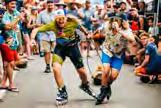
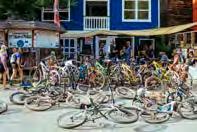
Kindred spirit and co-founder of the Sierra Buttes Trail Stewardship, Mark “Uncle Coz” Cosbey is a man of few words, but when he speaks, he makes it count, especially when looking back on the history of the Classic.

“We made the race happen during fires, we made it happen with massive amounts of snow, and most importantly to us, we did it when others doubted,” said Uncle Coz. “We all did it because we love it, and because we love each other. We’ve all got the passion for the Downieville Classic; whether you come to race or to volunteer or to just sit in the river with a cold beer. Friendships of
NAKOMA

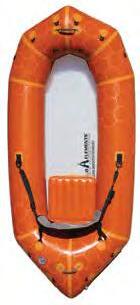

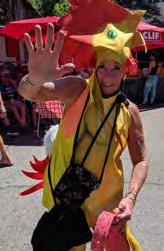
THE LOST SIERRA’S LUXE BASECAMP

Guests at the Inn at Nakoma have exclusive access to Altitude, our family friendly center with pool, climbing gym, theater, Bistro + Bar & more.




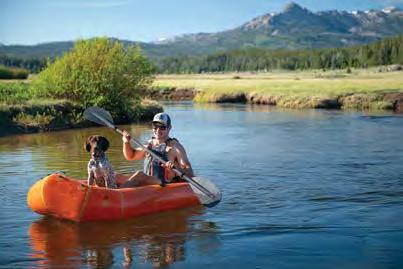



SPECIAL
a lifetime are made here, the more friends the better.”
For more information on Downieville Classic registration, volunteering and a schedule of events, visit downievilleclassic.com. For more information on Sierra Buttes Trail Stewardship, visit sierratrails.org.
Is there a better way to earn your beer than by volunteering for local outdoor events? San Diego Mountain Bike Association (SDMBA) held its annual Archipelago Ride, a fundraiser event for the local mountain biking community. I had the task of greeting and cheering people as they finished the ride with the strenuous climb up Lopez Canyon and then directing them down the road to Gravity Heights, a local brewery hosting the post-ride festivities. Watching people as they smiled and high-fived — or grimaced and gritted their teeth in the last push up Lopez — reminded me that when it comes to long rides, we never know what the experience is going to be when out on the trail. Assisting riders was very satisfying in knowing they accomplished their goal for the day and were then on their way to celebrate it.
When asked what the volunteer experience means to others, Ryan McBurney, the volunteer coordinator for the Archipelago Ride, said: “Volunteering for SDMBA’s large events like the Archipelago Ride and Trail Fest gives me a chance to meet some great people, reconnect with riding buddies, support SDMBA and be a part of an awesome community.”
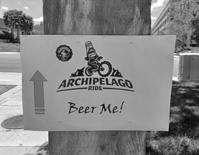
sdmba.com
Gravity Heights in San Diego provided the beer for the Archipelago Ride. On tap were Rice Cold Lager (4.5% ABV), a Japanese-style lager that is brewed with 40% rice. Daybreak IPA (7.2% ABV) was also on tap, a West Coast IPA.

Gravity Heights cofounder and brewmaster Skip Virgilio rode the full Arch (approximately 48 miles with some 5,000 feet of climbing). When asked about his experience on the trail and why Gravity Heights supports the local mountain biking scene, Virgilio said:
“The climb right out of the gate at La Costa and Elfin Forest were brutal. The rest went mostly smoothly all the way to the finish. During the event Gravity Heights was able to support SDMBA and we all got an awesome location for a party!”
The next time you’re in San Diego, make a point to check out Gravity Heights for grog and grub. They are conveniently located a couple of blocks from the Lopez Canyon trailhead. gravityheights.com


JUNE
8 — Quick n’ Dirty Summer Series, #6 / Escondido / QuicknDirtyMTB.com
10 — Bovine Classic x Firestone Walker Ride / Paso Robles / TheBovineClassic.com
10 — Giro di San Diego / Escondido / GiroDiSanDiego.com
10 — Fears, Tears, & Beers / Ely, NV / ElyNevada.net/fears-tears-and-beers
15 — Quick n’ Dirty Summer Series, #7 / Escondido / QuicknDirtyMTB.com
17 — Climb to Kaiser / Clovis / FresnoCycling.com/Climb-to-Kaiser
17 — Lake Tahoe MTB Race / Tahoe / AdventureSportsWeekTahoe.com
17 — Climb to Kaiser / Clovis / FresnoCycling.com/Climb-to-Kaiser
17 - 24 — Sierra to the Sea Bicycle Tour / Tahoe to SF / SierraToTheSea.org
18 — Spence Mountain Mayhem XC MTB Race / Klamath Falls, OR / bit.ly/SpenceRace
22 — Quick n’ Dirty Summer Series, #8 / Escondido / QuicknDirtyMTB.com
24 — Ruby Roubaix: Gravel Fondo / Lamoille, NV / RubyRoubaix.com
24 — Giro Bello / Sebastopol / GiroBello.com
24 — Groveland Grind / Groveland / New Date / Fundraiser for MTB trails / GrovelandTrailHeads.org
24-25 — Bike MS: LA Coastal Challenge / Santa Monica / BikeMS.org
1 — Truckee Tahoe Gravel / Truckee / TruckeeGravel.com

13 - 16 — Downieville Classic / Downieville / 25 Year Anniversary / DownievilleClassic.com
15 — Tour of the California Alps / Markleeville / World class cycling / You pick the challenge / DeathRide.com
15 — Bovine Classic x Cass Winery Ride / Paso Robles / TheBovineClassic.com
15 — Mt Shasta Enduro / McCloud / CaliforniaEnduroSeries.com
29 — Santa Cruz Mountains Challenge / Santa Cruz / SantaCruzMountainsChallenge.com
5 — Tour de Big Bear / Big Bear Lake / BigBearCycling.com
19 — Cool Breeze Century / Ventura / CoolBreezeCentury.com
19 — Pedalpalooza / Mammoth / sembabike.org/pedalpalooza
19 – 20 — Northstar Enduro / Truckee / CaliforniaEnduroSeries.com
26 — Crush Challenge / Yountville / CrushChallenge.net
2 — Tour de Fuzz / Santa Rosa / TourDeFuzz.org
2 — China Peak Enduro / Lakeshore / CaliforniaEnduroSeries.com
9 — Mammoth Gran Fondo / Mammoth Lakes / MammothGranFondo.com
9 — Race the Rails / Ely, NV / ElyNevada.net/Race-The-Rails
9 & 16— Ride the Rim / Crater Lake National Park / 25 miles and 3,500 feet of climbing / RideTheRimOregon.com
9 — Lassen Gravel Adventure / Susanville / BizzRunningCompany.com
11 — Rock Cobbler & Pebble Cobbler / Bakersfield / RockCobbler.com
16 — Tour of the Unknown Coast / Ferndale / TUCcycle.org
16 — Mammoth TUFF / Mammoth Lakes / Tuff.ventures
16 — Eroica California / Cambria / Eroica.cc/en/nova-california
22 - 24 — Silver State 508 / Reno, NV / the508.net
Go to the EVENTS page on our website for more information and direct links to events.
DATES AND DETAILS SUBJECT TO CHANGE. CHECK WITH EVENT PRODUCERS.
SEPTEMBER
23 — Coyote Classic XC Series #1 / Boulder City, NV / BootlegCanyonRacing.com
24 - 30 — OATBRAN / Bike Across Nevada / America’s Loneliest Bike Tour / BikeTheWest.com
30 — Ashland Mountain Challenge / Ashland, OR / CaliforniaEnduroSeries.com

30 — Sacramento Century / Sacramento / SacramentoCentury.com
OCTOBER
7 — Usal Hopper / Whitethorn / GrassHopperAdventureSeries.com
7 — Heart of Gold Gravel / Nevada City / HeartOfGoldGravel.com
21 — Hammer Road Rally / Shaver Lake / HammerRoadRally.com
28 — Filthy 50 / Escondido / QuicknDirtyMTB.com
NOVEMBER
10 - 12 — Singlespeed Cyclocross World Championships / Santa Cruz / sscxwc23sc.com
11 — Tour de Foothills / Upland / TourDeFoothills.com/
DECEMBER
2 & 3 — Dirty 30 & Dirty Cross / Lakeside / QuicknDirtyMTB.com
17 — China Camp Trail Run / San Rafael / InsideTrail.com
18 — Burton Creek Trail Runs / Tahoe City / TahoeTrailRunning.com
24 - 25 — Western States 100 / Olympic Valley / wser.org
JULY
4 — Run to the Beach LakeTahoe 5K & 10K / Tahoe Vista / TahoeTrailRunning.com
11 – 13 — Remembrance Run / Yerington to Carson City / Find “2023 Remembrance Run” group on Facebook
13 — Marlette 50K & 10 Miler / Spooner Lake, Tahoe / BigBlueAdventure.com
26 — Trail Run at Sly Park / Pollock Pines / tctruns.com
27 — Good Dog - Dirty Dog 5K/10K / Folsom SRA / TotalBodyFitness.com
JUNE
10 — Olympic Valley Half and 8 Miler / Olympic Valley / OlympicValleyHalf.com
10 — Holcomb Valley Trail Run / Big Bear / HolcombValleyTrailRuns.com
10 — Mt. Umunhum Ultras / San Jose / tctruns.com
11 — Dipsea Race / Mill Valley / Dipsea.org

17 — Rock Tahoe Half Marathon / Lake Tahoe / RockTahoeHalfMarathon.com
4 - 6 — Badwater 135 / Furnace Creek & Lone Pine / Badwater.com
8 — Rancho Hills Trail Run / Morgan Hill / tctruns.com
16 — Big Chief 50K / Tahoe / BigBlueAdventure.com
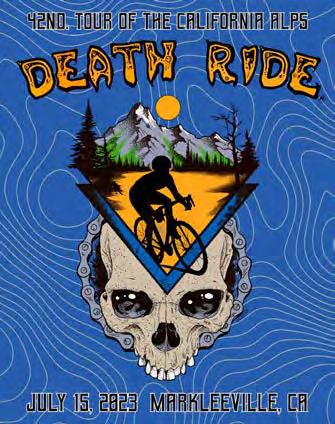
22 - 23 — San Francisco Marathon / SF / TheSFMarathon.com
29 — Truckee Half Marathon & 5K / Truckee / BigBlueAdventure.com
AUGUST
5 — Ward Mountain Trail Run / Ely, NV / ElyNevada.net
2 — She Rocks the Trails / Auburn / SheRocksTheTrails.com
10 — Buffalo Stampede / Sacramento / BuffaloStampedeRun.com
16 — Berkeley Trail Adventure / Berkeley / InsideTrail.com
16 — Bell Mountain Challenge / Apple Valley / MajesticCycling.com
17 — XTERRA Lake Tahoe 5K and 10K / Incline Village, NV / TahoeTrailRunning.com
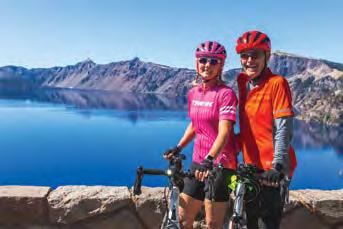


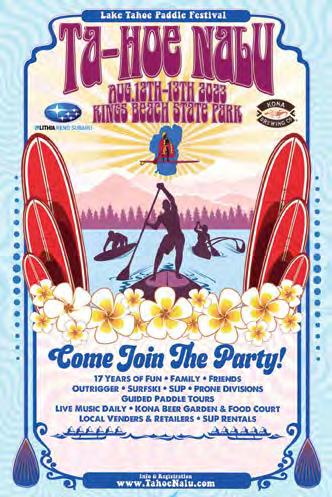

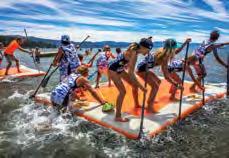

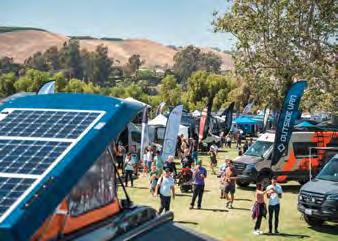





27 — Lake Tahoe Open Water Swim / Tahoe / TahoeSwimming.com
SEPTEMBER
17 — Mermaid Run San Francisco / Golden Gate Bridge / MermaidSeries.com
23 — Gold Rush Growler 10 Mile & 5K Trail Runs / Granite Beach / TotalBodyFitness.com
30 — Great Trail Race / Tahoe City to Truckee / 30K / GreatTrailRace.com
30 - Oct 1 — United Airlines Rock ‘n’ Roll San Jose / San Jose / RunRocknRoll.com/san-jose
JULY
23 — Alpine Fresh Water Swim / Donner Lake / TahoeSwimming.com
AUGUST
13 — Tahoe Sharkfest Swim / Incline Village, NV / SharkFestSwim.com
SEPTEMBER
30 — San Francisco Bay Area Open Water Swim / San Francisco / SwimAcrossAmerica.org
JUNE
10 — TRI for REAL #1 / Rancho Seco Park, Herald / TotalBodyFitness.com
24 — Tahoe Off-Road Triathlon / Tahoe City / AdventureSportsWeekTahoe.com
25 — Cal Tri Sonoma / Tahoe City / Sonoma.CaliforniaTriathlon.org
JULY
8 — TRI for REAL Triathlon #2 / Herald / TotalBodyFitness.com
9 — TRI for FUN Triathlon #2 / Herald / TotalBodyFitness.com
15 — Great American Triathlon / Sacramento / GreatAmericanTriathlon.com
22 - 23 — Donner Lake Triathlon / Truckee / DonnerLakeTri.com

AUGUST
6 — Tri Santa Cruz / Santa Cruz / SierraCascades.com
12 — TRI for REAL Triathlon #3 / Rancho Seco Park, Herald / TotalBodyFitness.com
13 — TRI for FUN Triathlon #3 / Herald / TotalBodyFitness.com
26 — Granite Bay Triathlon / Folsom Lake / TotalBodyFitness.com
26 – 27 — Lake Tahoe Triathlon / Lake Tahoe / BigBlueAdventure.com
SEPTEMBER
10 — Ironman 70.3 Santa Cruz / Santa Cruz / Ironman.com
17 — Pacific Coast Triathlon & Duathlon / Crystal Cove State Park / OCTriSeries.com
17 — XTERRA Lake Tahoe / Village Green, NV / BigBlueAdventure.com
17 — Shaver Lake Tri / Camp Edison / SierraCascades.com
24 — Santa Cruz Triathlon / Santa Cruz / SantaCruzTriathlon.org
OCTOBER
22 — San Diego Triathlon Challenge / San Diego / ChallengedAthletes.org
Adventure Van Expo / Various Locations / June 17-18, Hood River, OR / July 8-9, Evergreen, CO / Sept. 2-3, Ogden, UT / Sept. 16-17, North Lake Tahoe / Sept. 30-Oct.1, Bend, OR / Oct. 14-15, Big Bear / AdventureVanExpo.com

Moderately hilly & fun course. Great for the whole family.
Starts and finishes at Ramsay Park, near Watsonville’s wetlands.
The run is coordinated in conjunction with the Santa Cruz Track Club & the Watsonville Strawberry Festival held on Saturday & Sunday, August 5 & 6 at the Watsonville City Plaza.

Presented by Friends of Watsonville Parks and Community Services and The Rotary Club of Freedom. More info at FriendsOfWatsonvillePCS.org
march 18
Ensenada Bike Fest Enduro
presented by
May 20
Georgetown Enduro
July 15
Mt Shasta Enduro
August 19-20
Northstar Enduro
SEPTEMBER 2
China Peak Enduro
SEPTEMBER 30
Ashland Mountain Challenge
ASJ is proud to be a founding sponsor of the California Enduro Series
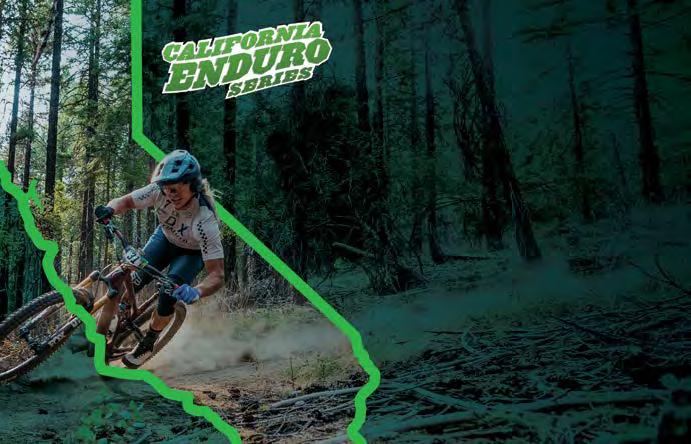
Go, dog, go! Your four-footed trail pal will be proud to schlep their own hydration in Ruffwear’s snazzy new Trail Runner™ Dog Running Vest. The vest is super easy to put on even the most fidgety pup, and it’s exceptionally comfortable. Ruffwear clearly put a lot of thought into its design; we really can’t think of anything to improve on! Made to move, the vest is adjustable, breathable, and – very importantly – bounce-free.
There are two zippered side pockets that securely hold Hydrapak® soft flasks (included). Additionally, a top zippered pocket can hold a collapsible bowl (check out Ruffwear’s Trail Runner™ Bowl) and poop bags-a-plenty. A reinforced webbing tow loop allows for secure leash attachment at the rear.
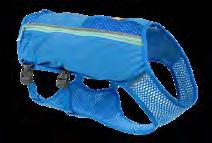
The Trail Runner™ Dog Running Vest comes in sizes from XS to L/XL, and comes in two vibrant colors for this season: Lichen Green and Blue Pool.
MSRP: $109.95 • ruffwear.com
SUP enthusiasts, rejoice! The Yakima SupDawg is the primo rack for transporting your paddleboard(s) securely and conveniently.
Designed with sturdy construction, this rack features padded cradles to protect your SUP during transport. It can accommodate up to two SUPs and is compatible with a wide range of board sizes and styles.
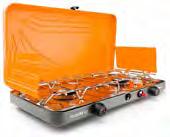
SupDawg’s tool-free installation makes it easy to attach and remove from your vehicle’s roof rack, while integrated straps ensure a secure and stable hold. Best of all, integrated rollers make for easy loading of oversized SUP boards. Racks and board are further secured by the included SKS locks. Also included is a bow/stern tie-down, although be sure to note if there are no attachment points for this, you’ll need to purchase the Hood Anchor, sold separately.
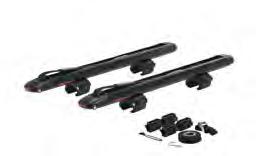
With its user-friendly design and reliable performance, the Yakima SupDawg rack is a trusted option for paddleboard enthusiasts looking for a hassle-free way to transport their boards to the water. We can’t recommend it highly enough!
MSRP: $349.00 • yakima.com

Shelter from the sun in style this summer with the Nemo Victory™ Sunshade. From beach to camp to backyard festivities and more, this spacious and lightweight sunshade will hook you up with a comfortable and protected area to relax in.
Mesh sidewalls offer UPF 50+ sun protection plus extra shade, yet don’t block the view. Set up is quick and easy with the shelter’s unique pole configuration. Two internal stash pockets provide a safe place for small personal belonging such as cell phones, glasses, and more.
Pair with the luxuriant Victory™ Picnic blanket (sold separately) for a waterproof and sand-resistant floor for the shelter.
The Victory™ Sunshade comes with duffel storage bag, stakes, guy-out cord, and repair patches.
MSRP: $199.95 • nemoequipment.com

The Astral Brewer 2.0 reigns supreme when it comes to versatility and performance. Designed with adventure in mind, the Brewer 2.0 is perfect for paddling, rock scrambling, and even mountain biking. Yes, we did say it’s versatile, didn’t we?
Excelling in wet conditions, the Brewer 2.0 features a durable and quick-drying upper made from Hydrophobic Canvas and Airmesh, ensuring comfort and water drainage. Its high-friction G.15™ rubber outsole provides excellent traction on both wet and dry surfaces, offering stability and grip.
The shoe also incorporates a removable and supportive EVA midsole for enhanced cushioning and comfort. With a lightweight and low-profile design, the Brewer 2.0 allows for natural foot movement and agile performance.
Additionally, these shoes are veganfriendly and built with sustainable materials, making them an environmentally conscious choice for outdoor enthusiasts seeking reliable and eco-friendly footwear.

Choose from a range of colors; also available in a women’s version (the Brewess).
MSRP: $125.00 • astraldesigns.com
GSI’s Selkirk 540+ camp stove offers reliable performance and compact design. Efficient, lightweight, and easy to carry, this award-winning stove was also constructed to be sturdy and durable, making it just right for those rugged outdoor conditions.
The Selkirk 540+ features twin 14,000 BTU/h burners with room for two 8” or 10” pots and a simple pushbutton ignition system. A wraparound windscreen helps to maximize heat efficiency and protect the flame from gusts of wind, ensuring consistent cooking performance even in challenging weather conditions. Finally, stainless steel and nickelchrome cooking surfaces make for easy clean-up … and we sure love that! Because who wants to end a great day of adventure scrubbing down the stove, right?
MSRP: $149.95 • gsioutdoors.com
As you surely know by now, we’re all about outdoor adventure products that take the environment into consideration. The Après Fish Slide is another such gem, as it’s constructed from an eco-friendly biodegradable injection molded EVA foam called BIOLITE.
Despite its simplicity, this lightweight one-piece sandal is durable and supportive, providing remarkable SRCrated slip resistance.
The Après Fish Slide is a great choice for any of your water adventures. It comes in unisex (black) and women’s (tie dye pink, pictured) sizes.
MSRP: $50.00 • xtratuf.com


Where some see rock, we see lines. Where some see peaks, we see possibility. Where some see rain lashed ridgelines or impenetrable fog, we see an opportunity to challenge our skills.

